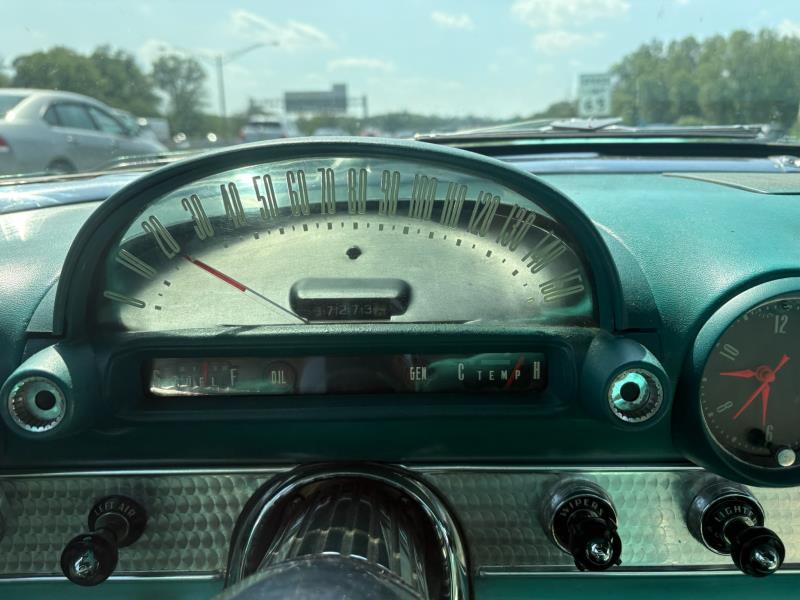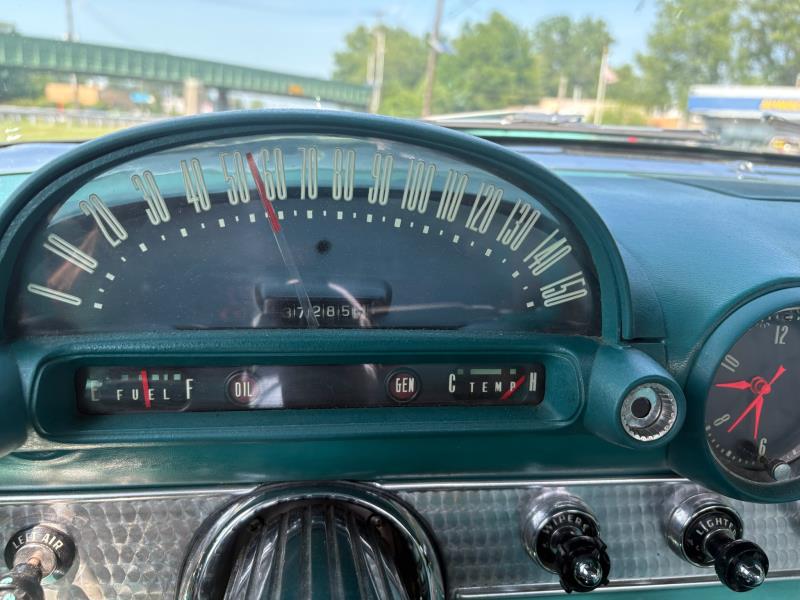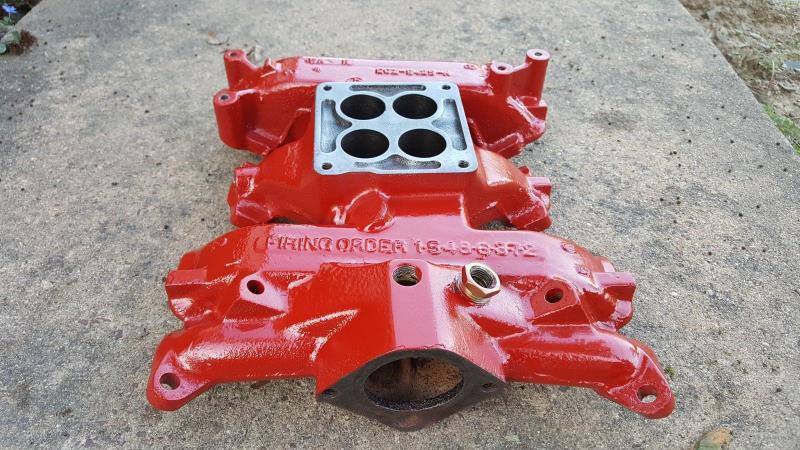|
Author
|
Message
|
|
RossL
|
|
|
Group: Forum Members
Last Active: Last Week
Posts: 67,
Visits: 7.1K
|
Is there a better location for the temp sender (1955 292 Tbird, 12 volt)? I've had the gauge pegged VERY HARD to the right, physically it could not more any further right. The car didn't boil over. An IR temp gun top tank was at 210 degrees. It ran OK, but I could feel a slight degradation to the idle from the under hood heat.
The gauge and sender in my car are from Casco. They are a matched pair that operates at 12 volts. I think the problem may be the location of the sender.
I would like to see something with a more useful scale. I don't feel like I would have any clue if the radiator will boil over or not
|
|
|
|
|
55blacktie
|
|
|
Group: Forum Members
Last Active: 7 hours ago
Posts: 1.2K,
Visits: 1.8K
|
Ted Eaton recommends relocating the temperature sender from the back of the driver-side head to the intake manifold. While he had my ECZ-B intake manifold, I asked Ted to drill & tap it for a sender. Looking at the engine from the front, the intake manifold was drilled and tapped into the coolant crossover, just to the left of the heater-control valve. This location, according to Ted, will provide a more accurate temperature reading than the location at the back of the head.
There are adapters that are attached to the upper radiator hose that will accommodate a temperature sender, but that location, which is in front of the thermostat, can give a false reading, in the event that the thermostat fails to open. Although my car is not back on the road yet, I'm retaining the original 55 Tbird sender and gauge (sender in original location), putting an AutoMeter sender in the manifold, and using an AutoMeter gauge. If one were to fail, the other will still be functional.
|
|
|
|
|
miker
|
|
|
Group: Forum Members
Last Active: 5 days ago
Posts: 1.9K,
Visits: 194.9K
|
The sender location isn’t ideal, but those old gauges weren’t all that accurate to begin with. Since they’re the King Seeley’s you can’t just add a resistor. There is some adjustment, but it’s almost impossibly to do unless they’re on a bench, hooked to a battery, and you can make small changes and wait.
Blacktie has the best solution. A 2 or 3 gauge panel. Water, oil, and volts if you’d like.
miker
55 bird, 32 cabrio F code
Kent, WA
Tucson, AZ
|
|
|
|
|
Ted
|
|
|
Group: Administrators
Last Active: 2 days ago
Posts: 7.5K,
Visits: 205.8K
|
The Ford Y-Block temperature sending location at the back of the engine typically reads 15°-20°F lower than what is seen at the thermostat. Moving the sending unit to the front of the engine will have the factory temp gauge reading a much warmer temperature. Relocating the sending unit is recommended when adding a non-stock temperature gauge, but the factory gauge will simply show a much hotter temperature when in reality nothing changed. Converting these engines to an aftermarket fuel injection setup will require that the temperature reading come from the front of the engine so it can have access to the warmer engine temperature reading.
  Lorena, Texas (South of Waco) Lorena, Texas (South of Waco)
|
|
|
|
|
RossL
|
|
|
Group: Forum Members
Last Active: Last Week
Posts: 67,
Visits: 7.1K
|
Ted (6/20/2025)
The Ford Y-Block temperature sending location at the back of the engine typically reads 15°-20°F lower than what is seen at the thermostat. Moving the sending unit to the front of the engine will have the factory temp gauge reading a much warmer temperature. Relocating the sending unit is recommended when adding a non-stock temperature gauge, but the factory gauge will simply show a much hotter temperature when in reality nothing changed. Converting these engines to an aftermarket fuel injection setup will require that the temperature reading come from the front of the engine so it can have access to the warmer engine temperature reading. Thank you. I did not realize moving the sender will give a higher reading. This was today (97 degrees), the car never boiled over. When I got home I checked the temps around the engine around thermostat 215, back of heads 220. Radiator top tank 190, bottom tank 160 Driving around town (around town the gauge is about middle of scale) and a few minutes on the highway with the AC on  This was at highway speed (avg 75) It's unnerving to ride around on a hot day with the gauge pegged: 
|
|
|
|
|
Litshoot
|
|
|
Group: Forum Members
Last Active: 11 hours ago
Posts: 35,
Visits: 503
|
You said you have a new gauge and sender, have you checked the wiring? High resistance is very common on these old cars and depending how the sensor reads or where the resistance is can cause low or higher than expected readings
Seth
|
|
|
|
|
Deyomatic
|
|
|
Group: Forum Members
Last Active: Yesterday
Posts: 292,
Visits: 2.3K
|
What thermostat are you running? I switched to the NAPA #6, 170 degree thermostat a few years ago and it made a HUGE difference in keeping it cool.
|
|
|
|
|
RossL
|
|
|
Group: Forum Members
Last Active: Last Week
Posts: 67,
Visits: 7.1K
|
Deyomatic (6/25/2025)
What thermostat are you running? I switched to the NAPA #6, 170 degree thermostat a few years ago and it made a HUGE difference in keeping it cool. I've tried 3. 180 degree with large opening, 160 with regular opening, 160 (MR Gasket high flow). The only difference between 180 and 160, the 160 was cooler UNTIL the engine and engine compartment reached full temp. Then the 160 didn't make any difference. The 160 with regular/smaller opening seemed to run the hottest I have a 170 with large opening, I will try that eventually. I don't think the thermostat is the issue. It's amazing how much contradictory information is "out there". I've read: (Use regular gas, Use premium gas) (More timing is better, Less timing is better) (Use an auxiliary pusher fan, an auxiliary pusher fan could block air flow) (Brass/copper radiator is better, Aluminum radiator is better) (High flow water pump is better, High flow water pump could pump too fast and radiator doesn't have time to cool the coolant)
|
|
|
|
|
55blacktie
|
|
|
Group: Forum Members
Last Active: 7 hours ago
Posts: 1.2K,
Visits: 1.8K
|
Ross, it sounds like you've done your homework, and you've hit on most of the things that have been addressed regarding what keeps our engines cool (or not). Unfortunately, what works for one might not work for all.
Before taking my bare block to a machine shop to be cleaned and magged, I removed all of the rust in the water jackets between cylinders. compared to images posted on CTCI Gil's Garage, mine looked pretty good. However, after the blocked checked out okay for cracks, I took it to a self-serve car wash and pressure washed it by inserting the pressure washer wand into the water jackets at the expansion/freeze plug holes and at the front of the block. I flushed out a lot of rust and rust-colored casting sand.
Engine condition and build quality can also make the difference between a cool engine and one that overheats, particularly if the head gaskets weren't correctly installed. Hopefully you'll get yours sorted out; if so, let us know what was required.
|
|
|
|
|
KULTULZ
|
|
|
Group: Forum Members
Last Active: 7 days ago
Posts: 1.8K,
Visits: 306.3K
|
 Above is a modified intake with correct positioning of the COOLANT TEMP SENSOR - If using an adapter as shown, make sure the SENDER BULB is fully submerged in the coolant. You need to consider a COOLANT RECOVERY SYSTEM for the engine. READ HERE - https://www.ctci.org/1955-56-57-thunderbird-overheating/AND HERE - https://www.fordbarn.com/forum/showthread.php?t=316470
____________________________
|
|
|
|